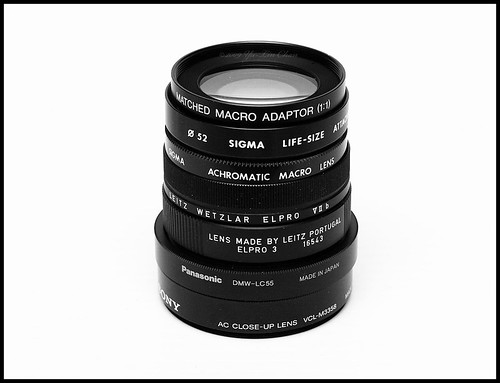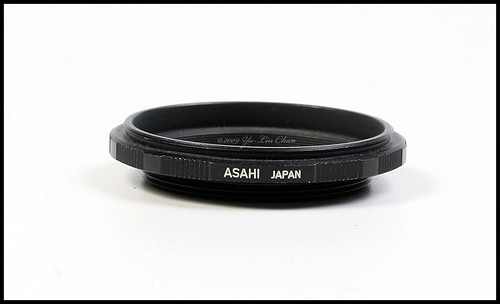If you have been looking for a macro lens, you know they are expensive. Auto focus version ranging from a few hundred dollars to around $1500 for a longer focal length. Even used manual focus macro lenses are not cheap. What to do when you want to try macro but don't want to shell out a stack of cash for a true macro lens? Well, there are many alternatives.
Close-Up Filters
The simplest and cheapest way to archive some sort of macro, is using close up filters. They come in all sorts of sizes and usually in sets of three. +1, +2, +3 or +4. Larger number indicates higher magnification. Using them is also straight forward. Just screw them in the front of your lens. As with all macro accessories, you can not focus to infinity once you have close-up filters in front of your lens. One down side to these filters, is that you will need different size filters for different size lenses.
The good -- Close up filter sets are very cheap and easy to use. Usually a 58mm set of 3 can be had for under $30. The cheaper one are un-coated. No light loss. You can stack multiple close-up filters to achieve higher magnifications.
The bad -- Image quality or the lack of. These filters produce acceptable images in the center of the picture. The corners are usually pretty bad, especially on full frame. Also, they are usually not optically corrected and no coating on the glass. You may not like the colour of colour fringing if you shoot back lit scenes.

Close-Up filter set -- the garden variety that is cheap but easy to use. Larger Picture.
Better Close-Up Filters -- Close up lenses
Like many products with different grades of the same thing, close-up filters also come in more exotic and expensive forms. They are usually called Close-Up Lenses because they are multi-element designs. Almost all of the these more expensive close-up lenses are coated, and most of them are multi-coated. Most of them have some sort of optical correction and some are achromatic. Older macro lenses usually has only 1:2 magnifications and they sometimes offered an optional 1:1 close up attachment filter. Many older Sigma macro lenses have this option. One of the best close-up lenses is produced by Canon -- the 500D.
The good -- Multi-Coated and optically corrected, which in turn produce much better quality images than the close-up filters. Some of them are matched to a specific lens, but that does not stop you from using it on any lens as long as the filter size are identical. Close up lenses also does not reduce the amount of light going through your lens, hence no light loss.
The bad -- Expensive. For example, the Canon 77mm 500D close-up lens costs about $250CAD, half the price of an entry level macro lens. Also, most close-up lenses do not product results as good as a true macro lens.

Variety of close up lenses in various sizes. Larger Picture.
Reversing Rings
Have you even looked through a lens in reverse, or used it as a magnifying glass? Most lenses, when viewed from behind, have a magnifying affect. The reversing ring allows you to mount your lens backwards to your camera. Reversing rings were, and still are popular choices to achieve very high magnifications. Basically, you mount a lens in reverse -- the front of the lens now becomes the back. Best focal length is the 50-100mm. Reversing rings are just like filters. They come in different sizes.
The good -- Exceptional image quality and very high magnifications.
The bad -- awkward to use, and not very good if the lens is heavy, as the filter thread on the lens was never meant to support the weight of lens. Prolonged use may put too much stress and damage your lens. Also, focusing is not possible. Another bad thing, unlike close-up filters or lenses, reversing rings are mount specific. You have to get a specific mount for your lens.

Pentax M42 reversion ring. Larger Picture.
We will talk about Extension tubes and focal length multipliers next time.
No comments:
Post a Comment